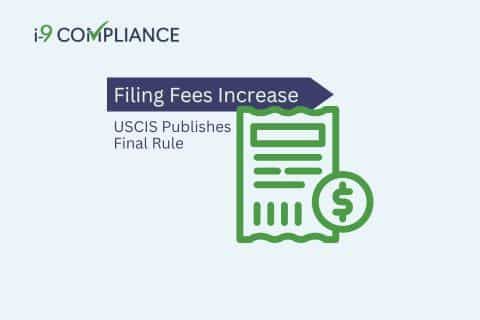USCIS Publishes Final Rule Increasing Filing Fees

The U.S. Citizenship and Immigration Services (USCIS) announced that it published the final rule concerning employment-based petitions. This rule will increase the cost of many petitions. These increases will take effect on April 1, 2024, and could prove extreme in many cases.
The proposal to increase costs appeared in January 2023. Since then, the new fees have caused significant debate. Many have commented on the steep increases for several petitions, especially the employment-based ones. A notable example concerns the H-1B cap registration fees.
These will increase from $10 to $215 per registration. This markup is a significant 2,050% increase. However, the $10 fee will remain in effect for the current registration season. This decision allows employers to prepare for the change.
The USCIS will also increase the cost of H-1B petitions by 70% from $460 to $780. Similarly, L-1 petitions will rise from $460 to $1,385 and O-1 from $460 to $1,055. H-2A and H-2B petitions will increase from $460 to $1,090 and $1,080, respectively.
In most cases, the final rule matched the January 2023 proposal. The Applicant to Register Permanent Residence or Adjust Status with biometric services (Form I-485) is an exception. This form’s cost will change from $1,225 to $1,440. This increase marks $100 less than expected under the initial proposal.
The USCIS received over 5,400 unique responses during the public comment period following the proposed rule. Though many opposed the increases, the USCIS held firm in its decision. The agency explained that increasing the fees would reduce the shortfalls it faced since updating its fee schedule seven years prior.
The USCIS Director Ur M. Jaddou explained, “For the first time in over seven years, USCIS is updating our fees to better meet the needs of our agency, enabling us to provide more timely decisions to those we serve.” The Director further commented, “Despite years of inadequate funding, the USCIS workforce has made great strides in customer service, backlog reduction, implementing new processes and programs, and upholding fairness, integrity, and respect for all we serve.”
Employers of foreign national workers should prepare for these increases before filing with the USCIS. One way to prepare is by covering the basics, such as the employment eligibility verification (Form I-9) process. This form has proven challenging before these fee increases, so employers should carefully prepare for unexpected complications. One way to avoid issues is to use an electronic I-9 management tool. This tool can guide personnel through every step, digitally and securely store all relevant documentation, and notify employers of when to take action.
Learn more about automating your employment eligibility verification and ensuring compliance with I-9Compliance.